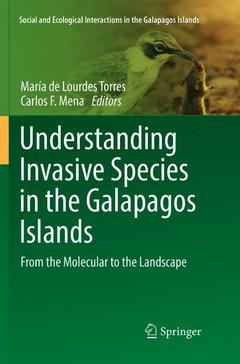Understanding Invasive Species in the Galapagos Islands, 1st ed. 2018 From the Molecular to the Landscape Social and Ecological Interactions in the Galapagos Islands Series
Coordonnateurs : Torres María de Lourdes, Mena Carlos F.

Preface
Introduction: Introduced Species and the Threats to the Galapagos
Chapter 1. A Preliminary Assessment of the Genetic Diversity and Population Structure of Guava, Psidium Guajava, In San Cristobal.
Chapter 2. Genetic consequences of invasive species in the Galapagos Islands.
Chapter 3. Interactions Among Exotics: Guava and its Associated Fauna in the Highlands of San Cristobal.
Chapter 4. A Study Contrasting Two Congener Plant Species: Psidium guajava (introduced guava) and P. galapageium (Galapagos guava) in the Galapagos Islands
Chapter 5. Quinine tree invasion and control in Galapagos: a case study. Heinke Jäger
Chapter 6. Allelopathic Impacts of the Invasive Tree Cedrela odorata L. (Meliaceae, Sapindales=Magnoliidae) in the Galapagos Flora.
Chapter 7. The Hitchhiker Wave: Non-native small terrestrial vertebrates in the Galápagos.
Chapter 8. Multi-Scale Remote Sensing of Introduced and Invasive Species: An Overview of Approaches and Perspectives.
Chapter 9. Remote Sensing of Invasive Species in the Galapagos Islands: Comparison of Pixel-Based, Principal Components and Object-Oriented Image Classification Approaches.
Chapter 10. Stakeholder Perceptions of Invasive Species and Participatory Remote Sensing in the Galapagos Islands.
Chapter 11: A Conceptual Framework for the Management of a Highly Valued Invasive Tree in the Galapagos Islands.
Conclusion: Conclusion and Management Implications.
Explores the problem of invasive species from a multi-scalar perspective, from the molecular to the landscape, and how each of these scales present conservation and management implications
Presents a series of studies in the Galapagos Islands, a unique place to study evolution, and now a unique place to understand how introduced species change the environment, creating challenges for endemic species conservation and for management strategies
Follows a multi-disciplinary approach, including studies from biology, genetics, ecology, geography and sociology, showing that talking about invasives necessitates the consideration of a broad spectrum of different aspects
Date de parution : 06-2019
Ouvrage de 237 p.
15.5x23.5 cm
Disponible chez l'éditeur (délai d'approvisionnement : 15 jours).
Prix indicatif 105,49 €
Ajouter au panierDate de parution : 02-2018
Ouvrage de 237 p.
15.5x23.5 cm



